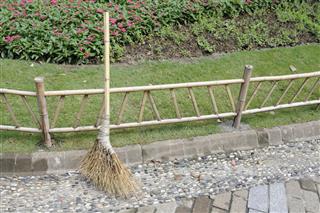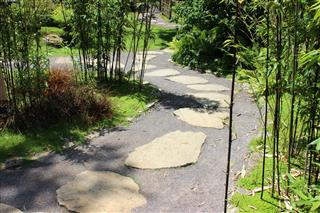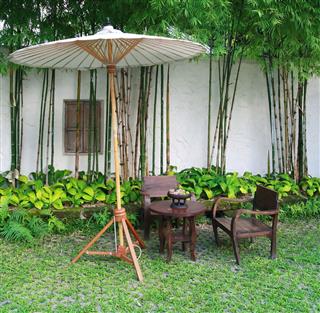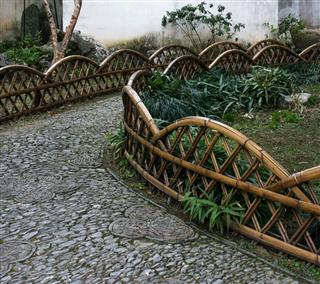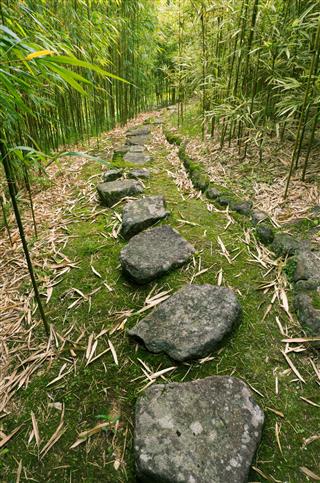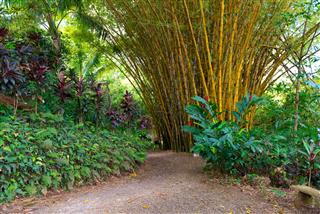
Bamboo is the largest member of the grass family. Among the various types of bamboo, there are some that are gigantic and almost treelike, while dwarf varieties can be small enough to grow in containers. Here we discuss the scientific classification of bamboos, their growth pattern, preferred temperature zones, and utility in everyday life.
Did you know?
Bamboo is used for making helmets, bicycles, and even cars! Yes, bamboo is the new steel which is being used for making lighter, edgier, and eco-friendly designs.
Bamboo is the fastest growing plant on Earth and is capable of attaining its full height and spread within a single growing season. The growth aspect of bamboos can determine whether it is a clumping or running species. Bamboos are evergreen plants that belong to the Poaceae family of grass. This giant grass is hardy enough to sustain harsh winters, drought, as well as the sweltering humidity of tropical regions. There are more than 10 genera of bamboo that have been divided into 1,450 species.
Unlike grass, the stalk of the bamboo is often woody from the outside, has nodes and is fibrous from the inside. The leaves are narrow and slender and their length in most cases depends upon the size of the bamboo plant. In some variegated species the foliage and stems have different colors and patterns which help in differentiating one species from the other. Following information will clarify the differences between the types of bamboo and their growing habits and preferred habitat.
| Bamboo Scientific Classification | |
| Kingdom | Plantae |
| Order | Poales |
| Family | Poaceae |
| Subfamily | Bambusoideae |
| Bambusoideae Groups | 1. Oryzodae 2. Bambusodae – Supertribe |
| Supertribe | Bambusodae |
| Tribe | Bambuseae |
| Bambuseae Subtribes |
|
Parts of a Bamboo
Rhizome: The underground stem or rootstock of the bamboo is known as rhizome. These rhizomes develop culms and roots which grow sidewards.
Bud: The new shoot that develops on the rhizome.
Shoot: The new culm that emerges from the subterranean bud.
Culm: The bamboo stem found beneath the culm sheaths.
Culm Sheath: The protective layer of leaves found on new shoots and culms. The sheaths fall off once the culm has developed its woody outer timber and attained its mature height.
Node: The rings of the bamboo stem found under the culms. The node is the septum or diaphragm that divides the hollow stem of the bamboo.
Internode: The part of the stem that is hollow and displays various colors and patterns according to varying species of bamboo.
Bamboo Growth Pattern
Monopodial – Running Bamboo
Just as the name suggests, running bamboos are fast-growing species that spread rapidly and cover vast amount of ground, thereby making them invasive in nature. Since monopodial or running bamboos are found in colder zones, these bamboos have rhizomes that grow horizontally and spread extensively in search of moisture and sunlight. The stems of a running bamboo grows in an invasive manner and can grow away from its mother or domain bamboo. Such bamboos can cover more than 15 feet of ground within a year and are capable of producing several culms on a single rhizome. The growth of these bamboos can be contained by ripping the roots after every few meters, so as to thwart the rhizomes from producing any more culms.

Sympodial – Clumping Bamboo
Clumping bamboos are slow-growing species that grow in large U-shaped clusters or clumps of culms. This type of bamboo is non-invasive because each rhizome produces only a single culm. Unlike running bamboos, the rhizomes are self-containing and sprout near the parent plant. New shoots appear from the ground in summer and grow rapidly from thereon. Clumping bamboos consist of both giant as well as dwarf species thereby making them ideal for urban settings. Even though this type of bamboo thrives in warm tropical climates, it can also be found in colder areas that experience frost.

Subfamily Bambusoideae
Bambusoideae is classified as a subfamily of the grass family of Poaceae and consists of two main groups, which are:
Oryzodae: These are herbaceous or non-woody grass. Oryzodae are not considered as true bamboos because unlike bamboo, these type of grass do not have indeterminate inflorescence, six stamens and three stigmas, culms or nodes. The Oryzodae group comprise 13 tribes which are as follows:
- Oryzaceae
- Anomochloeae
- Anomochlooideae
- Diarrheneae
- Ehrharteae
- Olyreae
- Oryzeae
- Oryzoideae
- Phaenospermatae
- Phareae
- Phyllorhachideae
- Streptochaeteae
- Streptogyneae
Bambusodae: The supertribe Bambusodae includes the tribe Bambuseae. This tribe comprises approximately 1000 identified bamboo species and 91 genera. The genera of the Bambuseae tribe includes only woody bamboos which are further divided into 9 subtribes. The subtribes of bambuseae are as follows:
- Arthrostylidiinae
- Arundinariinae
- Bambusinae
- Chusqueinae
- Guaduinae
- Melocanninae
- Nastinae
- Racemobambodinae
- Shibataeinae
Bamboo Temperature Zones
Neotropical Woody Bamboos
Neotropical woody bamboos are found in Central and South America, Mexico, and Caribbean Islands. It is believed that the subtribe Chusqueinae is the oldest among the three types of bamboo and originated in South America. Woody bamboos have leaves that are ligule and form a culm and sheath for protecting the shoots. Neotropical bamboos have three subtribes which are:
- Arthrostylidiinae
- Chusqueinae
- Guaduinae
Temperate Woody Bamboos
Temperate bamboos are cold hardy and can tolerate temperatures below 20° Fahrenheit. These type of bamboos grow in USDA zones of 5-8 and are native to Madagascar, Africa, Sri Lanka, Southern India, and South-East Asia. The two subtribes belonging to temperate bamboos are:
- Arundinariinae
- Shibataeinae
Paleotropical Woody Bamboos
The 460 species of paleotropical bamboos are scattered throughout Asia, India, Sri Lanka, Africa, Australia, and Madagascar. The four subtribes belonging to paleotropical woody bamboos are:
- Bambusinae
- Melocanninae
- Nastinae
- Racemobambodinae
Popular Types of Bamboos and Their Uses
Scaffolding and Construction
The pliability of bamboo makes it a suitable material for constructing bridges, houses, and for using as scaffolding. In Philippine, nipa houses are made entirely of bamboo and can withstand moisture and heat. Bamboo planks are also compressed and treated for making flooring, walls, and ceilings for houses. The biggest advantage of using bamboo timber is that, it can be cut without killing the plant. This unique aspect of the bamboo has made it an extremely popular choice among eco-conscious individuals. Some of the commonly used timbered bamboo species have been listed below.
- Giant timber bamboo – Bambusa oldhamii
- Petung bamboo – Dendrocalamus Asper
- Black asper – Dendrocalamus asper var. Black
- Velvet leaf bamboo – Dendrocalamus brandisii
- Atter bamboo – Gigantochloa atter
- Iron bamboo – Dendrocalamus strictus
- Taiwan giant bamboo –Dendrocalamus latiflorus
- Columbian thorny best – Guadua angustifolia
- Yellow bamboo – Gigantochloa apus
- Balcooa – Bambusa balcooa
- Giant bamboo – Dendrocalamus calostachys
- Java black – Gigantochloa atroviolacea
- Incense bamboo – Phyllostachys atrovaginata
- Golden square stem – Chimonobambusa quadrangularis
- Tropical blue bamboo – Bambusa chungii
- Tinwa bamboo – Cephalostachyum pergracile

Guadua angustifolia is believed to be the strongest bamboo in the world.
Flooring and Furniture
Bamboo being a timbered grass, grows rapidly and is thus available in plenty for commercial use. The popularity of exotic bamboo furniture increased during the 18th and 19th century, when Western countries began ordering for custom-made designs. Bamboo flooring on the other hand has gained popularity very recently and is being hailed as the long-term replacement for hardwood floors. Processed bamboo is not only sturdy, it is also resilient to moisture, heat, and pests. Following are some bamboo species that are used for making furniture and flooring.
- Moso bamboo – Phyllostachys edulis
- Timor black bamboo – Bambusa lako
- Monastery bamboo – Thyrostachys siamensis
- Balcooa bamboo – Bambusa balcooa
- Allgold – Phyllostachys bambusoides ‘Allgold’
- Yellow groove vivax – Phyllostachys vivax ‘Huangwenzhu’
- Castillon inversa – Phyllostachys bambusoides ‘Castillon Inversa’
- Kimmei vivax – Phyllostachys vivax ‘Huangwenzhu Inversa’
- Bengal bamboo – Bambusa polymorpha
- Spineless Indian bamboo – Bambusa tulda
- Golden common bamboo – Bambusa vulgaris
- Rawnal – Dendrocalamus longispathus
- Tursing – Dendrocalamus strictus
- Mautak – Melocanna baccifera
- Japanese timber bamboo – Phyllostachys bambusoides
- Pring tutul – Bambusa maculata

Fresh bamboo is dried in a mold or bent using heat to make furniture.
Edible Bamboos
Bamboo shoots are a staple food throughout Asia and are extremely nutritious. Almost all types of bamboos can be consumed, however, some are preferred over others for their flavor and size. Bamboo shoots must be harvested as soon as they are a foot tall. Since some shoots contain cyanide, the shoots must be boiled and leached before consumption. Once the shoots have been boiled, they can be stored for two weeks if they are soaked in cold water and kept in the fridge. The water must be replaced everyday in order to remove toxins and keep the shoots from rotting. While cooking bamboo, the shoots must be boiled for 30-45 minutes so as to remove their bitter taste. The boiled water must not be used for cooking and should be drained. Some delicious edible bamboo species have been listed below.
- Giant timber bamboo – Bambusa oldhamii
- Sri Pratchin – Dendrocalamus asper cv ‘Hitam’
- Philippines Sweet shoot bamboo –Dendrocalamus sikkimensis
- New Guinea edible bamboo – Nastus elatus
- Muli bamboo – Melocanna baccifera
- Moso – Phyllostachys heterocycla var. pubescens
- Edible sour bamboo – Acidosasa edulis
- Square bamboo – Chimonobambusa macrophylla
- Kan-Chiku – Chimonobambusa marmorea ‘variegata’
- Thorny bamboo – Chimonobambusa pachystachys
- Bambusa levis – Gigantochloa levis
- Hongke-leizhu – Phyllostachys incarnata
- Sweet shoot bamboo – Phyllostachys dulcis
- Elegant bamboo – Phyllostachys elegans
- Horn bamboo – Phyllostachys fimbriligula
- Fuyang wubujizhu – Phyllostachys nigella
- Nude sheath bamboo – Phyllostachys nuda
- Anji golden bamboo – Phyllostachys parvifolia
- Ziputou-Shizhu – Phyllostachys nuda ‘Ink-finger’

Bambusa oldhamii shoots are large, tender, and flavorful. These shoots are also canned and sold commercially.
Tools and Utensils
Bamboo is used for making utensils, tools, and carvings. In fact, in most Asian countries, the utensils of everyday use such as chopsticks, table mats, spoons, steamers, and flasks are made with bamboo. The roots of dead bamboo plants are used for making wall hangings and craft items such as carvings and ornamental walking sticks. Following are some types of bamboos that are used for making utensils, tools, and carvings.
- Slender weavers – Bambusa textilis var. ‘Gracilis’
- Spineless Indian bamboo – Bambusa tulda
- Giant bamboo – Dendrocalamus giganteus
- Muli bamboo – Melocanna baccifera
- Monastery bamboo – Thyrsostachys siamensis
- Bambus – Phyllostachys pubescens
- Tibetan Princess – Himalayacalamus asper
- Buddha’s Belly – Bambusa tuldoides ‘Ventricosa’
- Alphonse karr – Bambusa multiplex var. Alphonse Karr
- Black brandisii bamboo – Dendrocalamus brandisii var. black
- Mahal bamboo – Bambusa longispiculata
- Pervariabilis – Bambusa pervariabilis viridistriata
- Punt pole bamboo – Bambusa tuldoides
- Hitam – Dendrocalamus asper cv. hitam
- Membranaceus – Dendrocalamus membranaceus
- Indo bamboo – Dendrocalamus asper Indo
- Bushy bamboo – Bambusa oliveriana

The Thai sweet rice or khao lam is cooked and served in bamboo.
Musical Instruments
The bamboo plant has been used for making musical instruments since centuries. Instruments such as pan flutes, rainmakers, Australian didgeridoo, Korean Danso and Dangjeok, Indian flute or bansuri, Japanese Komabue, shakuhachi, and Kagurabue are predominantly made of bamboo. Hollow bamboo species with thin culms are chosen for the purpose of making musical wind instruments. The girth and hollow of the bamboo internode helps in determining the scale of the instruments. The following are some of the popular types of cane-like bamboos used for making these musical instruments.
- Umbrella bamboo – Fargesia murielae
- Arnhem land bamboo – Bambusa arnhemica
- Madaké bamboo – Phyllostachys bambusoides Sieb. et Zucc.
- Black bamboo – Phyllostachys nigra ‘Punctata’
- Carrizo – Chusquea liebmannii
- Mexican climbing bamboo –Chusquea coronalis
- Ghost bamboo – Dendrocalamus minor var. Amoenus
- Himalayan weeping bamboo –Drepanostachyum falcatum
- Khasia bamboo – Drepanostachyum khasianum
- Bisset bamboo – Phyllostachys bissetii
- Columbian thorny best – Guadua angustifolia
- Red Margin bamboo – Phyllostachys rubromarginata

The Red Margin bamboo is ideal for making musical wind instruments because it has long internodes and strong walls
Dwarf Indoor Bamboos
There are dwarf bamboo cultivars available which can be grown indoors in pots and containers. Indoor bamboo varieties must be given a lot of care and attention, partial shade and plenty of moisture. Small bamboo cultivars can also be used for making hedges, as ornamental additions for landscapes, and placed at the entrance of commercial buildings and houses. Following are some of the best dwarf bamboo cultivars that can be grown indoors.
- Malay dwarf green – Bambusa heterostachya
- Alphonse karr – Bambusa multiplex var. Alphonse Karr
- Chinese goddess – Bambusa multiplex ‘Riviereorum’
- Buddha belly – Bambusa tuldoides ‘ventricosa’
- Kimmei Buddha’s belly – Bambusa ventricosa ‘Kimmei’
- Golden square stem –Chimonobambusa quadrangularis
- Square stem bamboo –Chimonobambusa quadrangularis ‘Yellow Groove’
- Shiroshima – Hibanobambusa tranquillans ‘Shiroshima’
- Fish pole bamboo – Phyllostachys aurea
- Pygmy bamboo – Pleioblastus pygmaeus
- Dwarf greenstripe – Pleioblastus viridistriatus
- Dwarf whitestripe – Pleioblastus fortunei
- Arrow bamboo – Pseudosasa japonica
- Temple bamboo – Semiarundinaria fastuosa
- Green temple bamboo – Semiarundinaria fastuosa ‘Viridis’

A dwarf cultivar of bamboo being grown indoors.
Textile
Cotton is gradually being replaced by bamboo for making fabric, however much remains to be done in order to bring bamboo fabric into the mainstream market. Currently, processing bamboo into fabric is expensive and uses harsh solvents. Bambusa textilis is often used for making textile because its leaves and the pith from its thin-walled culms are easier to mash. The resulting threadlike pulp is used for weaving. Following types of bamboos are often used for making fabric.
- Moso bamboo – Phyllostachys edulis
- Dark weavers – Bambusa textilis var. ‘Fasca’
- Slender weavers – Bambusa textilis var. ‘Gracilis’
- Emerald bamboo – Bambusa textilis ‘Mutabilis’
- Smooth weavers – Bambusa textilis var. ‘Glabra’

Bamboo yarn is blended with cotton, hemp, or spandex to make fabric of varied texture.
A bamboo plant usually flowers after having reached the end of its life and will die soon after. Nonetheless, some types of bamboo flower annually and do not self-destruct like others.
The fruits produced by bamboos are edible as well and are relished by humans as well as animals. Therefore, since every part of the bamboo can be used for something or the other, it is one of the most giving plants on Earth.
